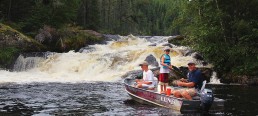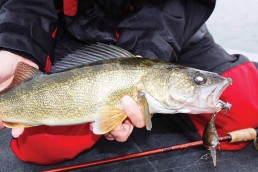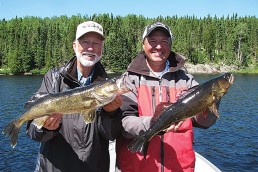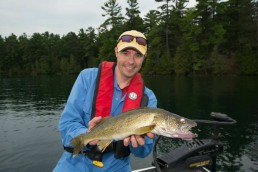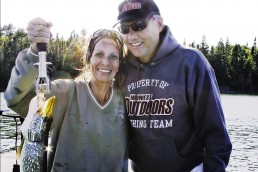Shallow Canadian Summertime Walleyes
How many Midwest Outdoors readers have heard the old wives’ tale about northern pike and walleyes “losing their teeth” in August? With presumably sore gums affecting the fish’s interest in feeding, some old-timers subscribed to this falsehood to explain why these two species became difficult to catch during the height of summer. On many Midwestern lakes, walleyes and pike indeed do become more challenging to entice, sliding into deeper, cooler water where angling tactics become more limited. Both of these species prefer cooler water with higher oxygen content, and northern pike especially prefer water temps in the low to mid-60s for the majority of their existence. However, as you venture north to explore Canadian fisheries, you’ll discover gamefish holding in shallow water throughout the open-water season. In fact, midsummer can offer the best walleye fishing of the year in Canada if you’re planning to go up there next year.
The majority of northern waterways feature some element of current. While some land-locked lakes may be absent of obvious inflow and outflow, these bodies of water are few and far between. The region encompassing northwestern Ontario, Manitoba, and the upper portions of Saskatchewan, a region well north of the Laurentian Divide, features waterways flowing northerly to Hudson Bay. Depending on which area of the province you are fishing, the lakes primarily may consist of lazy current, wandering streams with minimal water movement or spring-fed lake systems. Or, they may be dominated by rushing waterfalls spilling into or out of adjoining lakes with frothy, fast-moving, highly oxygenated water that congregates hungry predators. All of northwestern Ontario and much of the adjacent province of Manitoba are dominated by these types of waterways, as is Saskatchewan to the north of the prairies.
MidWest Outdoors contributor Tony Roach has fished many days in Canada over the years, both on recreational trips with family and friends as well as pitching in on MidWest Outdoors TV shoots. One such location highlighted by our cameras—Ghost River Lodges near Sioux Lookout, Ont.—offers numerous shallow-water fisheries where walleyes bite aggressively, even during the peak of summer when water temperatures are at their highest.
“Because it’s part of a river system, the interconnected lakes that are part of the Ghost River experience provide plenty of opportunities for anglers to cast in a lot of shallow-water current areas,” Roach says. “Throughout the year these locations not only give up a ton of walleyes, but a lot of BIG fish.”
He added that he loves to fish below the waterfalls.
“I love casting crankbaits, like number 5 Shad Raps as well as stickbaits like the new Shadow Raps and Shadow Rap Shads. Yellow Perch is a great color to toss in Ontario. By twitching them—adding pauses to your retrieve while fishing them in current—really throws that bait sideways and puts a lot of erratic action and flash in the bait that triggers strikes.”
He says a lot of the fishing here is done in 5 feet or less.
“Often, we’ll anchor up the boat right along the bank and pitch the current areas below those waterfalls,” Roach said. “Sometimes we’ll cast across the current and down-current and retrieve the bait upstream back to the boat. It all depends on how fast the water is moving and how the fish are reacting to the lures.”
While a simple jig and minnow combo or a jig tipped with a plastic trailer of some sort is all you need to catch Canadian walleyes, a bottom-hugging lure like a lead head can become a liability in current areas. Tumbling downstream, snags are a constant source of frustration. Even if the hook point or jig itself doesn’t hang up in the rocks, the moving water can push your line or leader in between two rocks and wedge the bait. A floating or suspending crankbait catches just as many fish as a jig-n-minnow, without the hang-ups. What’s more, artificial lures often catch bigger fish.
“Those walleyes are always ‘feeding up’ in that current,” says Roach, meaning fish might be on or near the bottom, but their predatory focus is on stunned or injured baitfish struggling in current above them. “Artificials that are fished upward tend to stay in the strike zone longer so you’re presenting the bait to opportunistic fish more on each cast than you would with a bait down in the rocks.”
If you want another example of how shallow walleyes will hold in summer in Canada, look no further than another instance Roach shared.
“There’s a group of customers that has been going to Ghost River for years, and one of their favorite things to do is throw topwater lures—at night—for walleyes in those same current areas. This can be a deadly tactic over the tops of shallow water reefs in the main-lake areas as well.”
Moreover, these reefs will hold big walleyes, plus northern pike and smallmouths if the fishery has these species, throughout the daytime hours, even in the dead of summer. There’s a misconception among some anglers that to catch walleyes in deep-water lakes in July and August you need to fish deep spots. Or, if it’s sunny and calm the walleyes will push down to deep water to avoid sunlight. This is not true. While 35- to 45-foot depths hold walleyes on some lakes during the dog days of summer (either on deep edges of shoreline breaks, deep tapering points or sunken reefs that top out at 35-45 feet surrounded by a deep main basin), it’s not uncommon to catch numbers of walleyes—especially bigger—on very high spots in the basin more consistently than off the deep edges.
“Canadian Shield lakes are flowage systems,” notes Roach, “and with water always on the move through these lakes you have current everywhere. You may not notice it out in the open areas of the lake as opposed to by the waterfalls, rivers and creeks, but it’s there. So, water is always flowing around and over these shallow reefs, and the shallower you get, the more current there is to attract and hold fish.”
He said in all the years of fishing in Canada there has been very few times where they had to fish deeper than 10 to 15 feet to put fish in the boat.
“Usually, the shallower those fish are, the bigger they are. Here’s another tip: Look for reefs that have boulders, chunk rock, broken rock rather than the big-slab bedrock reefs. Just like along the shorelines, those smooth sections of rock don’t hold baitfish and predators like that broken rock. Always key on reefs that feature boulders and chunk rock.”
Although Roach guides on Minnesota lakes, he’s equally enchanted with fishing north of the border in late summer.
“Canadian Shield lakes are so chock-full of bait and so fertile that walleyes don’t have to leave the shallows. They can stay there all the time, making them easy to catch. We are so zeroed in on that shallow bite that it becomes our focus. Oftentimes, the shallower the fish are, the bigger they are. Although we sometimes experiment with some swimbaits, we find that casting crankbaits to shallow structure or in fast-moving current areas is the best way to consistently catch fish. It’s all we’ll do on those trips.”
Roach added more on the summertime draw of fishing in Canada.
“I fish all over North America, but if there are trips I look forward to every year, it’s the vacations in Canada. The opportunities are endless for anglers, whether you’re chasing pike, muskies, walleyes, smallmouth bass or lake trout. You’re going into waters that may have never gotten fished, or be on a lake all day and never see another boat. The scenery is beautiful, the fishing is great—you can’t ask for anything more. When I think of fishing in Canada, it just puts a big smile on my face.”
During a MidWest Outdoors TV shoot this past August, Eddie Showalter and I were targeting walleyes on an outpost lake accessed via Showalter’s Fly-in Service. Like most of the “classic” Canadian walleye waters in this region of northwest Ontario, the lake is dominated by rocky shorelines, some weedy back bays, rocky main- lake islands and sunken reefs, and plenty of tapering underwater points and shorelines with current flowing into and out of the lake.
As we scouted the lake, the portable Humminbird unit marked fish at numerous depths, including lots of fish in the 18- to 30-foot range. Interestingly, these schools of fish were the least cooperative walleyes in the lake. Sure, we caught some fish when we dropped a jig-n-minnow down, but compared to the number of walleyes showing up on the electronics, the catching ratios seemed under par. However, when we shifted the boat shallower to vertically jig in 15 feet of water or less, we caught double-header after double-header. The biggest walleyes we caught came from 6 to 13 feet, triggered by pitching our jigs up shallow and slowly hopping and swimming them back to the boat.
On a personal note, three of the largest walleyes I’ve ever caught all came from skinny water. All three of these fish were released. Here is a synopsis of each:
1. A 32-inch, 11-pounder hit a Rapala Super Shad Rap I was long-lining behind the boat on Lake of the Woods. My angling partner trolled a number 18 Magnum Rapala. We were targeting huge northern pike (catching big walleyes as well) with large-profile lures, literally bouncing them through the rocks on shallow reefs in the middle of an expansive main-lake basin. Most of the reefs topped out at less than 9 feet with some high spots near the water’s surface or even exposed above it. The lake was mirror-calm, with sunny skies and air temps in the 80s in the middle of August.
2. I was casting and retrieving another Super Shad Rap across a shallow reef when a 31-inch walleye bit. We were targeting trophy pike on a high overcast July afternoon on Ontario’s Nungesser Lake.
3. A monster 34-inch fish (possibly 13 or 14 pounds) that bit a tiny number 3 Blue Fox Vibrax inline spinner. This is one catch that will always stick in my mind, of course because of the size, but more because of the location. It was a cool July day on Rainy Lake fishing for smallmouths. We were tucked deep in a back bay. Granted, this bay is a fairly large expanse and had plenty of deep water both in the bay, as well as in the main- lake basin that adjoins it. Regardless, this fish was “way back” from access to any deeper or cooler water. Overcast conditions and some wind may have aided the scenario, but the fish was so far back, so shallow by walleye standards, that it remains an odd catch to this day.
While we’re on the subject of fish tales, I’ll put one more out there. Scoff if you will, but this one’s as real as mom’s apple pie:
Years back, I was in “practice mode” for the Fort Francis Canadian Bass Championship on Rainy Lake, throwing a big, white paddle-tail swimbait around some shallow main-lake reefs. The particular reef where this occurred actually has a red hazard buoy/channel marker hanging on it and the reef is semi-attached to a string of small islands that mark the outer edges of a series of bays. This navigation channel happens to be the eastern edge of the main basin in this section of Rainy Lake.
Seeking smallmouth bass, I was intently watching the lure’s wobbling cadence on the retrieve, eyeballing the white swimbait for following fish that might be enticed from the reef—a section of structure so shallow it requires a hazard buoy to designate the rocks just below the surface. That’s when I noticed a fish riding deep below the bait, barely visible in the stained water. It was a dark-green shadow with a flash of white color as it subsequently rolled to one side and turned away.
Nice pike, I thought to myself, estimating it at 36 inches in length.
On the next cast—presumably—the same fish followed again, however, this time the fish was hot. It was all the way up to my feet and just under the surface behind the swimbait. Then it quickly darted away—a truly magnificent walleye, 3-footer, and as thick as a decent-sized carp.
To this day, I will swear that fish was brushing 17 pounds. I never saw her again, although I’ve returned to fish that location many a day since.
Such is the allure of Canada. Such is the attraction of angling experiences in the northern provinces. Such is the fascination with returning again and again to chase our fishy dreams, to entice rare specimens to bite, to breathe fresh, clean air and to listen to the stillness of nature. Such is the beauty and magnificence of Canada.
Have you made plans for your Canadian vacations yet? If not, now is the time to start.
MWO
SHARE THIS POST
Did you enjoy this post?
You can be among the first to get the latest info on where to go, what to use and how to use it!
